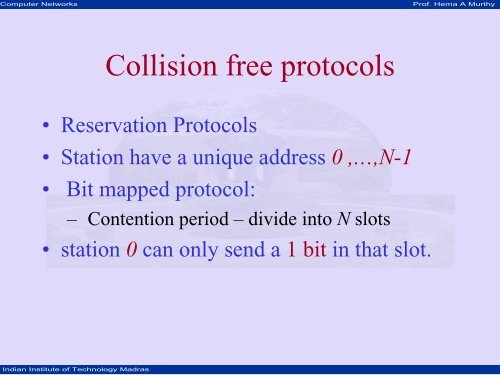Collision free protocols - nptel - Indian Institute of Technology Madras
Collision free protocols - nptel - Indian Institute of Technology Madras
Collision free protocols - nptel - Indian Institute of Technology Madras
You also want an ePaper? Increase the reach of your titles
YUMPU automatically turns print PDFs into web optimized ePapers that Google loves.
Computer Networks Pr<strong>of</strong>. Hema A Murthy<br />
<strong>Indian</strong> <strong>Institute</strong> <strong>of</strong> <strong>Technology</strong> <strong>Madras</strong><br />
<strong>Collision</strong> <strong>free</strong> <strong>protocols</strong><br />
• Reservation Protocols<br />
• Station have a unique address 0 ,…,N-1<br />
• Bit mapped protocol:<br />
– Contention period – divide into N slots<br />
• station 0 can only send a 1 bit in that slot.
Computer Networks Pr<strong>of</strong>. Hema A Murthy<br />
<strong>Indian</strong> <strong>Institute</strong> <strong>of</strong> <strong>Technology</strong> <strong>Madras</strong><br />
<strong>Collision</strong> <strong>free</strong> <strong>protocols</strong><br />
• Station j announces that it has a frame to<br />
transmit by inserting a bit in slot j.<br />
• After all N slots have passed by –<br />
– every station knows numerical order<br />
– Now transmit in Numerical order<br />
• no collision at all!
Computer Networks Pr<strong>of</strong>. Hema A Murthy<br />
<strong>Indian</strong> <strong>Institute</strong> <strong>of</strong> <strong>Technology</strong> <strong>Madras</strong><br />
<strong>Collision</strong> <strong>free</strong> <strong>protocols</strong><br />
• After last ready frame transmitted –<br />
– an event generated<br />
• New N bit contention period<br />
• If a station misses<br />
– wait for next contention period
Computer Networks Pr<strong>of</strong>. Hema A Murthy<br />
<strong>Indian</strong> <strong>Institute</strong> <strong>of</strong> <strong>Technology</strong> <strong>Madras</strong><br />
<strong>Collision</strong> <strong>free</strong> <strong>protocols</strong><br />
• After all stations have transmitted<br />
probability <strong>of</strong> having a frame to transmit<br />
middle <strong>of</strong> slot<br />
– wait 1 ½ contention period before transmitting<br />
• Always 1 bit/station/frame transmitted is the<br />
overhead
Computer Networks Pr<strong>of</strong>. Hema A Murthy<br />
<strong>Indian</strong> <strong>Institute</strong> <strong>of</strong> <strong>Technology</strong> <strong>Madras</strong><br />
Efficiency<br />
0 1 2 3 4 5 6 7<br />
1 1 1<br />
High<br />
Low<br />
d<br />
−<br />
load<br />
load<br />
frame<br />
U=<br />
U=<br />
size<br />
1-<br />
contention<br />
d<br />
1 3 7<br />
Nd<br />
d<br />
d<br />
+ 1<br />
+ 1
Computer Networks Pr<strong>of</strong>. Hema A Murthy<br />
<strong>Indian</strong> <strong>Institute</strong> <strong>of</strong> <strong>Technology</strong> <strong>Madras</strong><br />
Contention Free Protocols<br />
• Binary Countdown:<br />
• Better than bit mapped <strong>protocols</strong><br />
• Use binary station addresses<br />
• Each station broadcasts address<br />
– Example: 0010 0100 1001 1100
Computer Networks Pr<strong>of</strong>. Hema A Murthy<br />
<strong>Indian</strong> <strong>Institute</strong> <strong>of</strong> <strong>Technology</strong> <strong>Madras</strong><br />
Contention Free Protocols<br />
• All addresses same length<br />
• Bits in each position from different stations<br />
are ORed<br />
• <strong>Collision</strong> avoidance<br />
– arbitration rule<br />
– if high order bit position <strong>of</strong> station address<br />
overwritten by 1 give up!
Computer Networks Pr<strong>of</strong>. Hema A Murthy<br />
0010<br />
0100<br />
1001<br />
1100<br />
1111<br />
<strong>Indian</strong> <strong>Institute</strong> <strong>of</strong> <strong>Technology</strong> <strong>Madras</strong><br />
Binary CountDown<br />
Compare give up<br />
give up<br />
1100 – gets access!<br />
Next new cycle <strong>of</strong> contention start<br />
Compare next bit<br />
Compare next bit<br />
1001 gives<br />
up
Computer Networks Pr<strong>of</strong>. Hema A Murthy<br />
Binary CountDown:Analysis<br />
<strong>Indian</strong> <strong>Institute</strong> <strong>of</strong> <strong>Technology</strong> <strong>Madras</strong><br />
U<br />
=<br />
d<br />
d<br />
+ ln2<br />
If the higher order bits <strong>of</strong> a station j address are 1,<br />
station j transmits continuously<br />
N
Computer Networks Pr<strong>of</strong>. Hema A Murthy<br />
Limited Contention Protocols<br />
• combine the properties <strong>of</strong> contention and<br />
collision <strong>free</strong> <strong>protocols</strong><br />
• contention at low load to provide low delay<br />
• reservation at high load<br />
<strong>Indian</strong> <strong>Institute</strong> <strong>of</strong> <strong>Technology</strong> <strong>Madras</strong>
Computer Networks Pr<strong>of</strong>. Hema A Murthy<br />
Adaptive Tree Walk Protocol<br />
• Adaptive TreeWalk Algorithm<br />
– low load<br />
<strong>Indian</strong> <strong>Institute</strong> <strong>of</strong> <strong>Technology</strong> <strong>Madras</strong><br />
• every body contends<br />
– collision –<br />
• reduces number <strong>of</strong> stations
Computer Networks Pr<strong>of</strong>. Hema A Murthy<br />
Adaptive Tree Walk Algorithm<br />
4<br />
<strong>Indian</strong> <strong>Institute</strong> <strong>of</strong> <strong>Technology</strong> <strong>Madras</strong><br />
1<br />
2 3<br />
5<br />
a b c de f g h<br />
First contention all stations permitted to contend<br />
6<br />
- if collision then next slot only nodes under 2 can contend<br />
-if success next slot – Nodes under 3<br />
-if collision then nodes under Node 4<br />
-if success next slots Nodes under 5<br />
7
Computer Networks Pr<strong>of</strong>. Hema A Murthy<br />
Adaptive Tree Walk Algorithm<br />
• Depth first tree walk algorithm<br />
• Heavy load do not start searching at top <strong>of</strong><br />
tree<br />
– what level to start the search?<br />
– depends on number <strong>of</strong> ready stations<br />
<strong>Indian</strong> <strong>Institute</strong> <strong>of</strong> <strong>Technology</strong> <strong>Madras</strong>
Computer Networks Pr<strong>of</strong>. Hema A Murthy<br />
Adaptive Tree Walk Algorithm<br />
• Each node at level i has N. 2 –i station under<br />
it.<br />
•qready stations – uniformly distributed at<br />
level i 2 -i q<br />
• level at which search begins<br />
– 2 -i q =1<br />
– i = log 2 q<br />
<strong>Indian</strong> <strong>Institute</strong> <strong>of</strong> <strong>Technology</strong> <strong>Madras</strong>
















